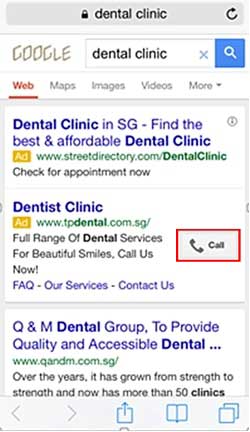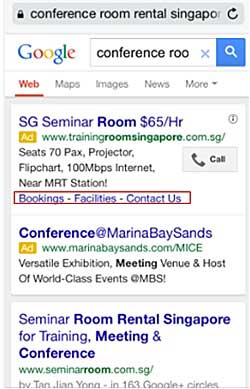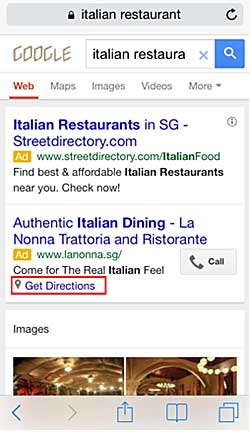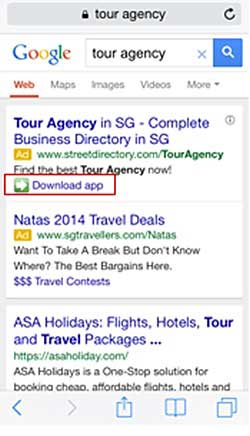Marketing your business is way more than just crafting a message and deciding how to split your budget; it's also about keeping up with trends and putting your money where you'll get the best returns.
The Internet is a dynamic realm, and online marketing is in constant flux, including search engine marketing, which has evolved over the years with more sophisticated search algorithms and targeted results.
If you haven't started search engine optimization (SEO) or pay-per-click (PPC) advertising, it's not too late. If you have, then you need to complement it with mobile advertising. The key is to include mobile marketing as part of your overall Internet marketing strategy.
Consider the following example:

Does that sound familiar? We're all guilty of being reliant on our mobile devices, and it's something we can see all around us: Young and old alike have their eyes glued to their phones.
But what some companies haven't caught on to yet is that this new behavior can be a marketing opportunity for them.
What We All Know About Mobile SEM
- Highly targeted: One of the key benefits of SEM is its targeted nature, which is even more applicable for mobile. Location services on smartphones allow advertisers to go about their advertising in an even more targeted manner.
For example, if I operate a restaurant in the central area of Singapore and run SEM ads, I have the technical ability to strategically target users within a two kilometer radius who search for "restaurants near me." Business owners can choose to target customers who are more likely to opt for locations in their vicinity. This approach can be a cost-effective method for advertisers who have a smaller budget but still want a presence online. - Lower cost: Compared with desktop cost per click, the CPC for the same keyword on mobile tends to be lower, according to the Search Agency. Furthermore, mobile and tablet click share has gone up 29% in Q1 of 2014 vs. Q1 of 2013. What this means is that you're paying less for each potential customer while securing your position in an expanding market. Of course, desktops still account for the majority of clicks, but ignoring the growing mobile trend would be detrimental to business growth.
- Response: The mobile phone is inherently a personal device, and that translates to user behavior: 90% of mobile users take some action as a result of a Google search, according to Google. Those actions could be in the form of a purchase, a visit to the business, or a continuation of research. No other form of advertising can claim such a high response rate or as much consumer engagement.
Catching Clicks With Google Mobile Extensions
We're all fighting for the consumers' clicks, and it's no different on the smartphone, tablet, or desktop. Standard SEM best-practices also apply to mobile, of course, but Google has also implemented a range of extensions and features to increase conversions for mobile. Take advantage of them to get the most out of your advertising dollar.
Click-to-Call Extensions

Click-to-call extensions allow searchers to call your business directly without going to your site and looking for your number. Remember: people are conditioned to use the phone for calls; calling you for information on their phones comes naturally to them.
Mobile Site Links

These site extensions enable users to directly enter the page they're interested in, without having to navigate through the rest of your website. The easier you make it for searchers to get to what they want, the less frustrated they will be and the more inclined to make a purchase.
Location Extensions

The best way to reach out to local customers would be through location extensions. Let searchers know where you are and how to get to you. The phone is a symbol of convenience, and your ad can show that. If your business is close to them, the more likely they are to want to employ your services.
App-Promotion Ads

A lot of time spent on the mobile is spent on apps. With so many apps available in both the Apple app store and the Google Play store, it's hard to get noticed by users. The app-promotion ads (previously "click-to-download") allow you to promote your apps when users search for you.
You've Got Them Where You Want Them... Now to Keep Them There
A study by Google and AnswerLab (PDF) on 100-plus mobile users provided valuable insights on user behavior on the mobile. As expected, it found that attention spans tend to be shorter. Accordingly—and keeping in mind the smaller screen—the information you display should be of utmost relevance to the customer.
Customize Mobile Sites
Keep your calls to action prominent, where users will not miss them. Visitors to your site will have an easier time trying to contact you, while secondary information can be kept below the fold. If you have menus, keep them simple. Mobile users typically don't have the patience to scroll through an extensive list of options, and what works on the desktop won't on the mobile.
A Search Function
If you're looking for something specific, the natural inclination would be to search for it. Of course, the results have to be relevant. The participants in the Google and AnswerLab study judged a site's search based on the initial page of results returned and did not bother swiping to more than one search results page. Added functions such as filters, auto-complete, and auto-correction of misspellings can aid you in making sure the results are relevant to the customer so that they stay on your site.
Ensuring Conversions
Getting them into your website is half the battle won, but making sure they convert is a much more complex task. A turn-off for mobile users is having to register before purchase, especially if they are unfamiliar with the brand. Offering a guest checkout prevents users from getting frustrated and questioning how registration would benefit them. It boils down to one thing: The smoother you make the process, the better the chance that the customer will follow through.
Form Entries
Entering text into forms can be one of the most tedious tasks to do on a mobile device, but it doesn't have to be; just small, simple tweaks make a world of difference. Streamline the information-entry process by automatically presenting number pads for fields that require it, such as birthdays or telephone numbers. Do you have a long list of options for certain fields? A drop-down menu offers a straightforward method of input. Finally, real-time validation offers users immediate feedback regarding the information they enter and prevents the need to resubmit; it serves as a guide for users and alerts them of any problems before they hit submit.
Site Usability
If you're designing a mobile site, commit to it and have your entire site mobile-optimized instead of just specific pages. Participants in the study had more difficulty navigating sites that had a combination of desktop and mobile-optimized pages vs. pure desktop-version sites. Be careful of your labels, though, and avoid offering a "full site" option, which causes users to be wary that the mobile site was condensed and contained less information. If your mobile site contains all the necessary information, consider doing away with the option of clicking to a "full site" version; if you must, label it "desktop site" to help avoid such perceptions.
What Next?
On mobile devices, everything boils down to one thing: convenience. Customers are out there looking for you and what you offer. Mobile marketing has become a component of search marketing that you shouldn't miss out on.
You can use mobile to get the attention of searchers; use it to ensure they follow through and become your client instead of just another site visitor who left without taking action.
Incorporate the techniques noted in this article into your online marketing, and you'll see your conversions on mobile rising faster than you can say "Hello!"




